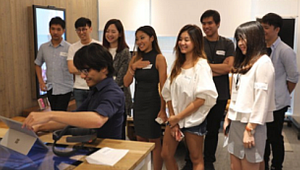
A Month With The Microsoft HoloLens

First off, hand on heart – I am still blown away. Yes, it has a couple of minor nuances like the letterbox view and the occasional gesture-control frustrations, but it is still epic.
But why put words down when I’m only a month in? Why not wait until we’re “all over it” and have some things to show – a flashy client case study, perhaps? Because, I fear, that we are not all over it. And by we I mean you, me, anyone who has an interest in the future of interfaces. As I have been fortunate enough to do some traveling with a shiny new HoloLens kit, it’s blisteringly clear that people do not really know about it. Maybe because the Microsoft people have confined it to geek-domain in their minds? Or maybe it’s because there are so many headsets available this year? Whatever the reason, I don’t care. I’m here to tell you that the HoloLens is not only awesome, but represents a significant shift in how we see the future of Human-Computer Interaction, and how close we are to a tipping point that will change the way we work!
I was fortunate enough to play with a HoloLens beta at Microsoft's Redmond campus last year, and was expecting to be impressed, but skeptical.
Turns out, I was completely sold on the concept, its fidelity, and the fact that it runs on Windows 10 native. The box was opened, and immediately people wanted to play – and not just the techies. I was relieved to see such a broad group totally captivated by it – very different from other headsets. I brought it back to the UK to get some peace and quiet to have time to play.
The things I learned
People respond the same way to the HoloLens. All of them love it; all of them see a future using this tech for work or for pleasure. When comparing it to recent VR or AR experiences, they talk about the implications across fields of interest: car guys talking about how useful it would be for tutorials; gamers talking about multiplayer real-world first-person shooters; data teams talking about collaborative modelling; IT talking about removing all their desks, screens and phones.
That said, there’s definitely a gap in engagement time with different generations, regardless of background – and I mean everyone from a two-year-old to a 69-year-old. The basic rule of thumb is that the older you are, the less you can move your neck! Seriously, it seems that the people born into technology can look around the mix of real and virtual with practically zero doubt or worry that their heads will fall off, whereas (for the sake of argument) those over 35 wait until they’re sure they’re in control before they move their necks!
The things I’m worried about
I mentioned it was good right? Well, so was the App store, so was VR, so was... the internet – and, to be fair, they all still are, but have one thing in common – the digital landfill.
We saw it with AR – thousands of apps that do the same thing, and no one really knows why they need it (use once, chuckle, delete). Now we’re seeing it with VR. What are the implications? Can’t think of one? Let’s do a campaign gimmick.
Why am I worried about this for HoloLens, when it’s a perfectly natural evolution of a new technology? Because the HoloLens is so much more than dancing monkeys and floating spacemen. I worry that like the rush for VR, companies and agencies will go straight for the easy win rather than focusing on the journey that shows the power of such a great kit.
It should make you think: “What would motivate me to put the headset on in the first place? What scenarios work best – complete scenarios, not just individual tasks? What makes the headset better than a couple of other screens?”
It’s game-changing tech, and everyone has a responsibility to figure out how to change our world.
As a result, I’m looking forward to Cortana being more involved with what you’re doing as a proactive assistant and more focus on the link between physical and digital – maybe teleconference interactions, where physical objects are scanned and transported. It would also be great to get a physiologist’s view on how the HoloLens can be used to affect behavioural changes, efficiency, focus, etc.
I guess as we see more software, more reasons to use this type of tech, and more sensor/haptics to make the experience even more immersive, we’ll know if this is/was the tipping point toward the office of the future.
I shouldn’t mention “more software and more reasons” without a minor reference to Pokémon GO; if that isn’t suited to HoloLens, I don’t know what is. Even Microsoft’s CEO called Pokémon GO “HoloLens Gold.” It isn’t just the fact that you can play it without running in the road, knocking over a small child, or falling down a manhole (less chance, anyway). Having the characters mapped to real physical space and being able to interact, as well as 360-degree sound, adds a level of immersion I bet the developers wished they had access to before HoloLens was released – just look at how quickly the unofficial game developer jumped onto the bandwagon.
Sounding a bit like a stuck record here, but I want people not to get too focused on just the tech, but to think of its implications. And the more non-geeks, the merrier – and the sooner the better!
- Matt Webb is global CTO of Mirum. You can follow him on Twitter @webgeekwebb.
This article originally appeared on Contagious.










